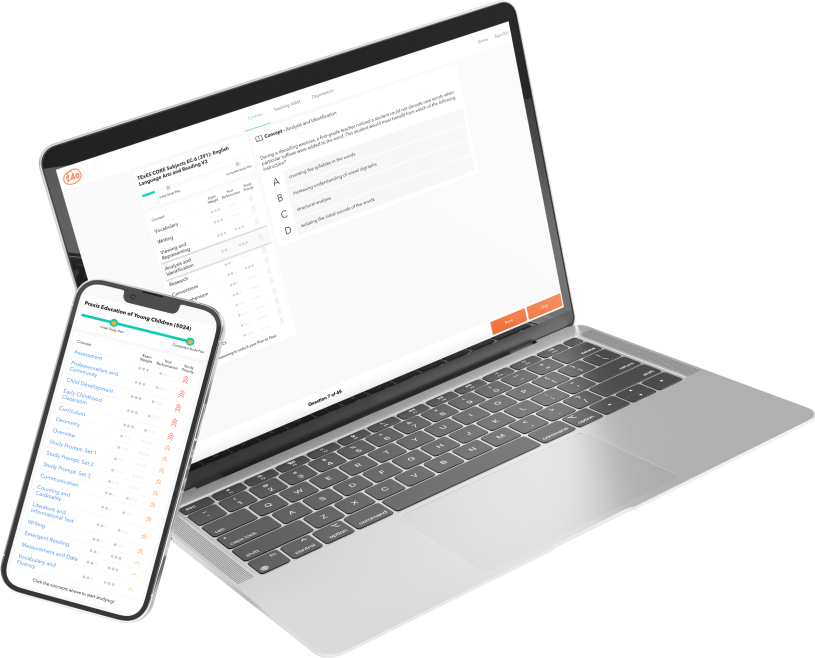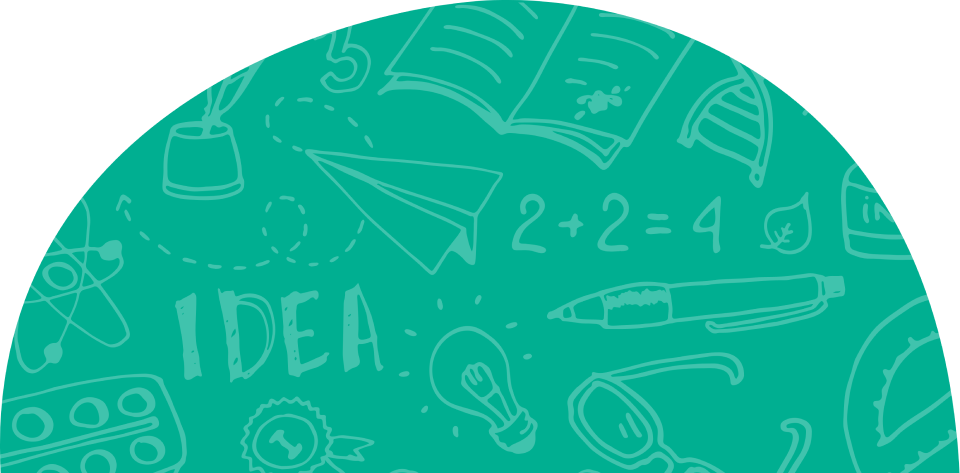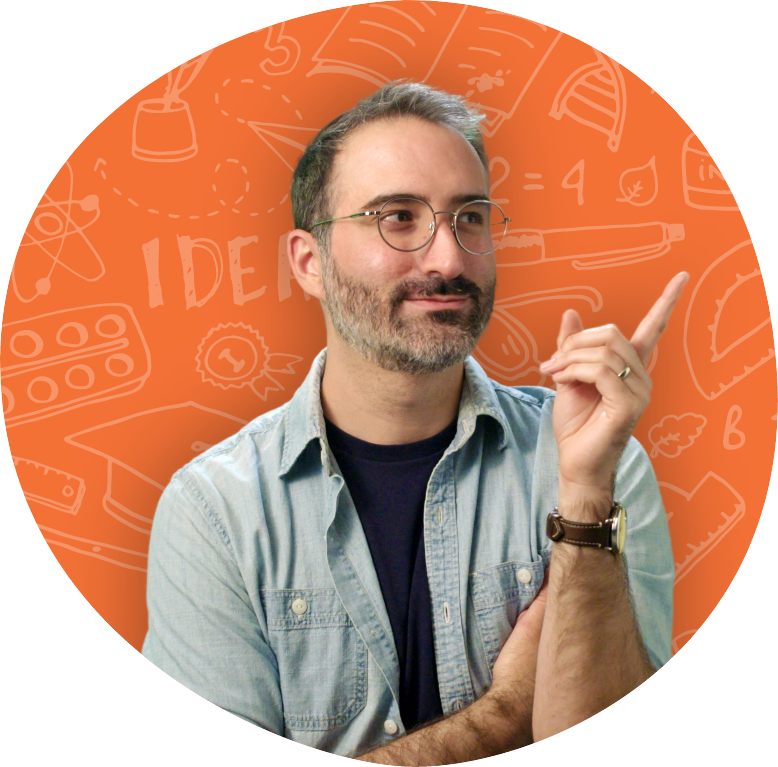Welcome to our NES Assessment of Professional Knowledge: Elementary practice test and prep page. On this page, we outline the domains and key concepts for the NES Assessment of Professional Knowledge: Elementary exam. It is a free resource we provide so you can see how prepared you are to take the official exam.
While this free guide outlines the competencies and domains found on the exam, our paid NES Assessment of Professional Knowledge: Elementary study guide covers EVERY concept you need to know and is set up to ensure your success! Our online NES Assessment of Professional Knowledge: Elementary study guide provides test-aligned study material using interactive aids, videos, flash cards, quizzes and practice tests.
Will I pass using this free article? Will I pass using your paid study guide?
If you use this guide and research the key concepts on the NES Assessment of Professional Knowledge: Elementary exam on your own, it’s possible you will pass, but why take that chance? With our paid study guide, we guarantee you will pass.
→ Subscribe Now: Assessment of Professional Knowledge: ElementaryNES
Quick Links to Help You Navigate This Page
- NES Professional Knowledge: Elementary Exam Test Information
- Professional Knowledge Elementary Domain I: Student Development and Learning
- Professional Knowledge Elementary Domain II: Assessment, Instruction, and the Learning Environment
- Professional Knowledge Elementary Domain III: The Professional Environment
- Professional Knowledge Elementary Constructed-Response Breakdown
NES Assessment of Professional Knowledge Elementary Test Information
NES Assessment of Professional Knowledge-Elementary Test Information
The NES Assessment of Professional Knowledge exam is designed to address today’s needs for knowledgeable teachers. This test assesses an elementary teaching candidate’s understanding of professional knowledge and practices.

The NES Assessment of Professional Knowledge- Elementary test is a computer based test that consists of 100 multiple-choice questions, 1 case study written assignment, and 1 work product written assignment (both explained below). You have 3 hours to complete all sections of the test.
Cost:
$95.00
Scoring:
The national benchmark score is 220, but the passing score varies depending on the state you are seeking licensure from.
Study time:
When deciding how long you need to prepare for an exam, first evaluate how much of the tested content you are comfortable with, then make a plan for how much you need to study. Most teachers plan to study a few months before taking the test. Be sure to make a plan that is best for you.
What test takers wish they would’ve known:
- Study as much as you can.
- Arrive early and prepared the day of the test.
- Read test instructions very carefully.
- Plan out how you will use the time given to take the test.
- Answer all test questions.
- Maintain a positive attitude.
Information and screenshots obtained from NES.
Professional Knowledge Elementary Domain I: Student Development and Learning
Overview
Content domain I has about 30 questions which accounts for about 24% of the entire test.
This content domain contains three competencies:
- Human Development
- Learning Processes
- Diverse Students
Human Development
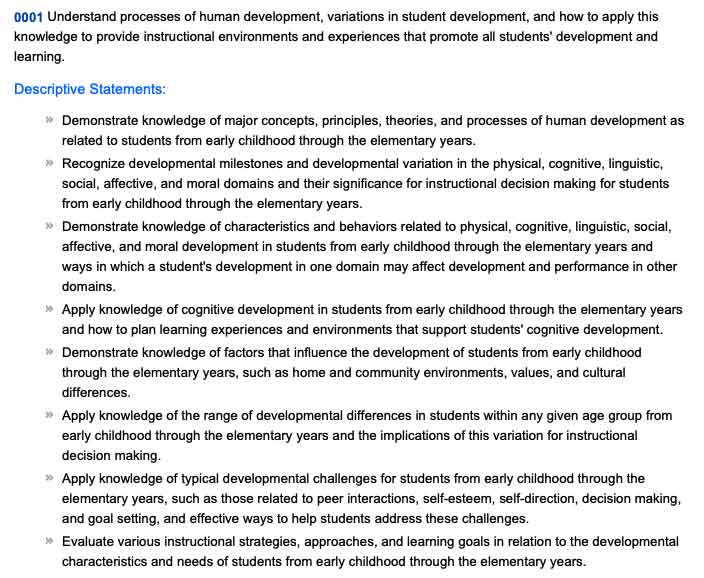
Take a look at these concepts that are likely to appear on the test.
Jean Piaget’s Theory of Cognitive Development
Jean Piaget (1896-1980) was a Swiss psychologist who is best known for this theory of cognitive development in children. Piaget proposed through his theory that intelligence in children grows and develops through stages and he also believed that children played an active role in the learning process. Piaget believed that children learn by interacting with their environment, continually adding new knowledge and building on previous knowledge. Building on previous knowledge is known as schema.
Schemas are categories of knowledge that help people understand the world around them. As children experience new things, their schema is changed. For example, if a child has an experience with a house cat, the child might think that all cats are small, fluffy, and eat food from a can. Then maybe a year later the child visits the zoo for the first time and sees a tiger. The child will absorb this new information and modify his/her understanding of cats.
Children adapt throughout the learning process. Three parts of adaptation are:
- Assimilation: The process of taking in new information into schemas that already exist. In the cat example, seeing the cat at the house and at the zoo and naming it “cat” is an example of assimilating that animal into the child’s cat schema, or what the child knows about cats.
- Accommodation: The process of changing existing schemas when new information is learned. This involves changing existing schemas and developing new schemas. In the cat example, accommodation happened when the child saw a different type of cat at the zoo and understood not all cats look like a house cat.
- Equilibration: The balance between assimilation and accommodation. As children grow developmentally, Piaget proposes that it is important to maintain a balance between applying previous knowledge (assimilation) and changing thoughts (accommodation).
Piaget’s theory was considered revolutionary at this time because until this point children were not considered unique in terms of development and were treated like small adults. Piaget’s theory proposed that children go through four stages of cognitive development:
- Sensorimotor stage (0-2 years)
This stage is takes place over a short period of time, but involves a huge amount of cognitive growth. During this stage a child will grow through experiences with senses, motor responses, and basic reflexes. Children will learn by looking, listening, sucking, and learning to grasp objects. At this stage, children learn object permanence which is a major milestone during this stage.
- Preoperational stage (2-7 years)
Children who are going through this stage begin to think symbolically and begin to use language to describe objects. Language development is the major development during this stage. At this time, children are very self-centered and struggle with logic. For example, a teacher might divide a piece of play-dough into two pieces and ask the child to choose a piece. The teacher might have one piece of play-dough rolled into a ball, while the other is smashed flat. Even though the pieces are the same amount of play-dough, the child will most likely choose the flat piece because it appears larger.
- Concrete operational stage (7-11 years)
Children begin to think logically during this stage. They begin to organize their thoughts better and in the example above, would understand that each piece of playdough has the same amount of playdough, just in different shapes. Children in this stage become less self-centered and begin to consider how others may feel in a given situation.
- Formal operational stage (12+ years)
At this stage children begin to think abstractly and consider morals, ethics, and social and political issues. At this point, children are capable of figuring out multiple ways to fix a problem and they think more scientifically about their environment.
It is important for teachers to consider Piaget’s Theory when planning learning experiences to meet the needs of the various stages of student’s cognitive development. Teachers should:
- Encourage peer learning. This is even more important for students in the preoperational stage (2-7 years), but is valuable at every stage. When students learn from their peers they learn to listen carefully and thoughtfully to different perspectives which provides long term benefits.
- Make learning opportunities out of mistakes. Piaget proposed that children developed knowledge best by trying things and making mistakes. Mistakes can frustrate students and you as the teacher, but teachers should work to guide students towards a different conclusion. When children make mistakes, that demonstrates that the child is actively interacting with his/her environment and trying new things.
- Focus on the process of learning as well as the result. Focus on the steps it took to get to the finished product, rather than being “right” or “wrong”.
- Respect student’s interests, abilities, and limits. Children will reach milestones at different points; rather than pressuring students to change their learning style, change your lessons to fit their needs. Piaget was an advocate for giving children opportunities to discover new things and offering as many hands-on activities as possible.
Lev Vygotsky’s Social Development Theory
Lev Vygotsky was a Russian psychologist who, like Piaget, proposed a theory about child development, but Vygotsky’s theory was based more on social rather than intellectual development. The Social Development Theory proposes that social interaction comes before development and consciousness and cognition are the end product of socialization. Vygotsky’s Theory includes:
- Social interaction- Vygotsky says that learning happens before development and that it begins on the social level (parent to child) rather than on the individual level (inside the child).
- MKO (more knowledgeable other)- Anyone who has a better understanding or a higher ability level than the child. A teacher is an example of an MKO, but the MKO could also be a peer or even technology.
- ZPD (zone of proximal development)- The ZPD is the measure between a student’s ability to complete a task with support and the student’s ability to complete the task independently. Vygotsky proposes that this is where learning occurs for a child.
Traditionally many teachers instruct students by lecturing or giving information to students. Vygotsky’s theory opposes this type of instruction and suggests that rather than lecturing, teachers should have an active role in learning and students should have more say in planning and delivering instruction. Teachers can collaborate with students to help develop meaningful instruction and at that point learning becomes a more meaningful experience for students and teachers.
Learning Processes
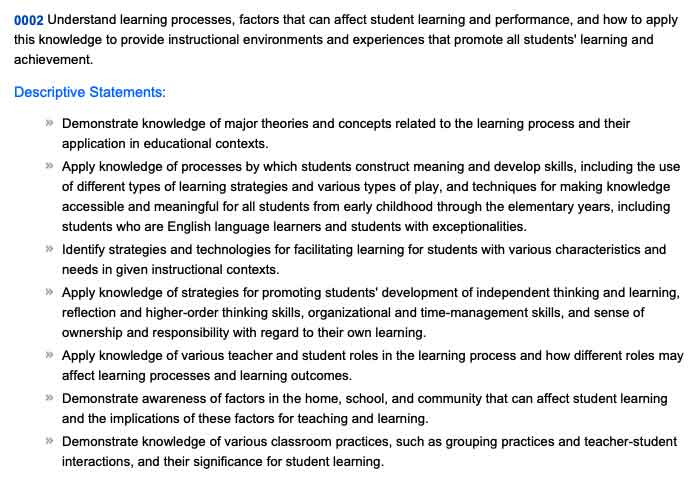
The following concepts are important to know.
Types of Play
Sociologist Mildred Parten suggested that when children actively play they learn how to interact with others, cooperate, and make friends. Parten proposed that as children develop, their play changes through six stages that most often correspond to the child’s age. Types of play include:
- Unoccupied play– The child does not appear to be engaged or actively playing with others. The child does not move and has no objective. This type of play is most often associated with babies and young toddlers (0-2). This type of play is vital for future types of play and exploration.
- Solitary play– Children play alone with toys but appear unaware or uninterested of others around them. Young toddlers most often demonstrate this type of play, but it is an important skill for all children. Solitary play is most often seen in young toddlers because they have not developed the cognitive and social skills to play alongside others. This skill is important because it teaches children how to entertain themselves.
To support solitary play, teachers should:
-Notice what children are exploring.
-Become part of the play audience (join in if they are making a pretend phone call, etc.).
-Encourage and praise solitary play.
-Help children identify emotions experienced through solitary play.
- Onlooker play-Children begin to notice others while they are playing, but they do not join in the play. Typically, children begin to do this between 2.5 and 3.5.
- Parallel play– A type of play that happens when children play side-by-side, but the play lacks involvement. At this stage children will typically play with similar toys and mimic one another. At this stage children are learning important skills that help develop more advanced play skills.
To support parallel play, teachers should:
-Encourage mirroring by students/peers.
-Help students identify emotions and recognize the emotions of others
- Associative play: Children begin to play together, but do not have a common goal. This is different than parallel play, but at this stage children are more interested in what other children are doing. Children may trade toys or speak about their activity with one another.
To support associative play, teachers should:
-Encourage sharing.
-Notice what each child is contributing and encourage that.
-Encourage imaginative and creative play.
- Cooperative play: The final stage of play is where children begin to work together cooperatively. At this stage, children are interested in the people and activities around them. Children typically begin to play cooperatively between 4 and 6 years of age because this type of play requires advanced organizational skills and social maturity.
To support cooperative play, teachers should:
-Support students sharing their perspectives.
– Help students set goals for their group.
-Practice problem solving by discussing conflicts. Always guide students towards understanding/empathy.
Grouping Practices for Effective Instruction
Teachers should choose the way students are grouped based on the lesson or activities’ purpose. It is important for teachers to carefully consider the learning objective and goal so that the appropriate grouping technique can be used.
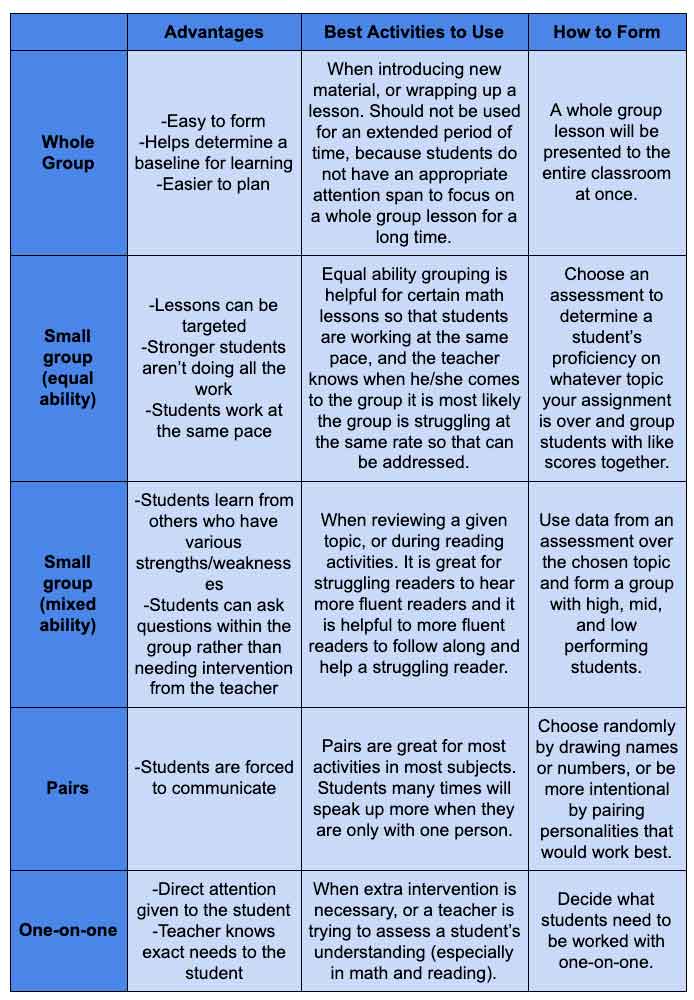
Higher-Order Thinking
Higher-order thinking, or HOT, names the process of thinking on a level that is deeper than simple memorization or re-telling of a concept. Higher-order thinking requires students to memorize facts, but then apply them in higher ways. For example, common HOT skills used in the elementary classroom are:
- Using metaphors, similes, analogies- These help by explaining abstract things and connecting them with familiar concepts. For a child to use a metaphor, simile, or analogy, he/she must be able to form deeper connections than simple memorization.
- Visualization- Using pictures, rather than words to explain something.
- Inferencing- To draw a reasonable conclusion based on given evidence.
- Problem solving- Encourage students to be creative and use several strategies when solving a problem.
- Brainstorming- Students generate ideas either individually or in a group.
- Metacognition- Thinking about thinking, or understanding the process of thinking and understanding a person’s own strengths and weaknesses.
Teachers can encourage higher-order thinking by:
- Teaching students what higher-order thinking is and is not
- Encourage students to ask questions
- Connecting concepts across curriculum
- Modeling inferencing
- Using graphic organizers
- Encouraging creativity
- Asking students to elaborate short answers
Diverse Students
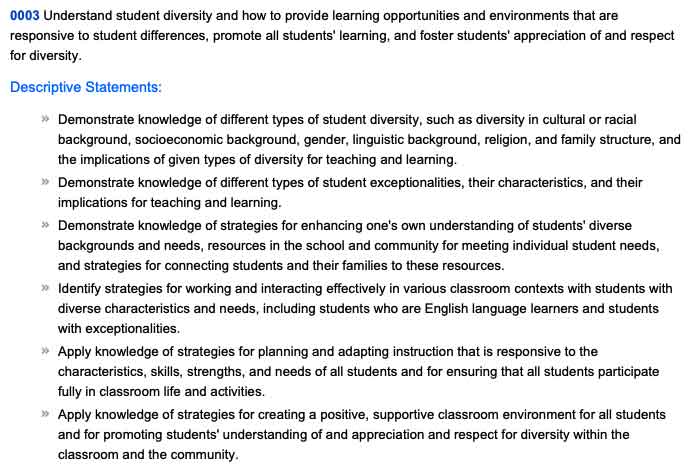
Major Categories of Disabilities

English Language Learners
Over 10% of students in the United States are considered English Language Learners, or ELLs. This means that most classrooms today have students who are considered English Language Learners, or ELLs. Some ELLs may speak little to no English, and others may speak some, but regardless, there are specific strategies for working and interacting effectively with ELLs.
- Make visuals.
- Incorporate group work.
- Recognize the “silent period”.
- Provide scaffolding in the student’s native language as much as possible.
- Teach language across the curriculum, not in isolation.
- Provide students with sentence stems to use when providing written or oral responses.
- Differentiate instruction.
- As students to speak, write, and draw for as many assignments as possible. Using multiple modalities helps students acquire language faster.
- Build relationships and work to understand the student’s native language/culture.
The two items ELLs need in order to acquire English as a new language is time and practice. All of the strategies listed above are specific ways to give the student time and or practice to improve their English. Another important point is that ELLs need multiple opportunities to participate in structured group activities so that they are given the opportunity to hear/understand English, but also to explain concepts using English to contribute to their group. While observing the group, the teacher can gauge the ELLs mastery of not only the academic concept, but also the English language. It is also important to repeat instruction regularly. When a student is acquiring a new language, they may only pick up a small part of what was said because they are working so hard to understand. When you repeat what you said, a video, as a student to repeat an answer they’ve given during an oral discussion, the ELL has an opportunity to process the same information again and most likely acquire more from it each time.
And that is some basic information about Domain I: Student Development and Learning of the Professional Knowledge: Elementary exam.
Professional Knowledge: Elementary Domain II: Assessment, Instruction and the Learning Environment
Professional Knowledge: Elementary domain II has about 50 multiple-choice questions and 1 constructed-response (case study) question which account for about 50% of the entire test.
This content domain contains five competencies:
- Assessment
- Instructional Planning
- Instructional Approaches
- Motivation and Communication
- The Learning Environment
So, let’s talk about Assessment first.
Assessment
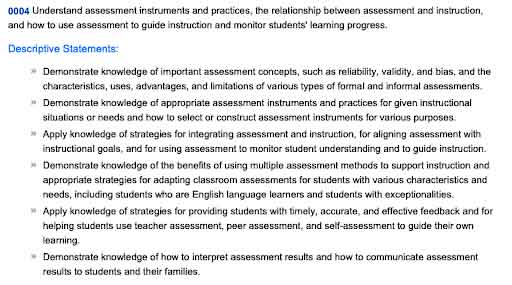
The following are really important concepts from this competency.
Reliability, Validity, and Bias
There are two types of assessments (more on that in the section below), but no matter what type of assessment a teacher is giving he/she needs to make sure the assessment is:
- Reliable– How consistent student’s scores are. Also, if alternate versions of a test are given (such as a re-test or make up test) they must be equivalent so that students are not automatically scoring higher on one than the other.
- Valid– How well does the assessment measure the specific learning objective it is evaluating. An assessment should measure content that was explicitly taught. This is important because if a teacher is making a decision about instruction or intervention based on data from the assessment, then the test should only consist of the material that students were given the opportunity to learn.
- Lacking bias– Assessment grades should reflect a student’s mastery of the learning objective, rather than the question. For example, using idioms in a question that is not testing idiom usage would be very difficult for an English Language Learner to understand. The student might understand the concept you taught, but if you asked a question over that topic in a way that confused the student due to a lack of understanding of language, that is a biased question.
To ensure that assessments are reliable, valid, and without bias, teachers should:
- Create assessments PRIOR to instruction.
- Deconstruct standards carefully when planning an assessment. Know the verbs of the learning standard and understand EXACTLY what the student should know and be tested over.
- Plan assessments as a team.
- Consider levels of thinking.
- Offer multiple ways to respond on the same assessment (some multiple choice, fill in the blank, short answer, etc.)
Types of Formal and Informal Assessment
There are two types of assessments used in classrooms today.
Formal Assessments
Formal assessments include any type of standardized test that is data driven and compares students to their peers. Formal assessments should be used after learning has taken place, and the goal is to see how well a student has mastered a specific standard or set of standards.
An example of a formal assessment would be a state standardized test. Data from these tests are compared and students are usually placed into percentiles as they are compared to peers who took the same assessment. Formal assessments are advantageous in that they provide teachers with a picture of what students have mastered vs. what they have not, however, they are usually “high stakes” tests and often create a lot of anxiety for students taking them. Due to the “high stakes” nature of formal assessments, students will sometimes not demonstrate mastery due to an outside factor such as stress or worry about the test, so teachers are left wondering why the student seemed to understand the concept and do well on informal assessments, but then did not show mastery on a formal assessment.
Informal Assessment
Informal assessments are NOT data driven, but performance and content driven. Informal assessments are also referred to as criterion referenced measures should take place during learning and should be used to plan further instruction.
An example of a powerful informal assessment is a running record in reading. Running records are great informal assessments because they show how well a student is reading a specific text. Running records show mastery and growth (so still valid assessments), but usually compare an individual student’s scores to previous scores, not the scores of other students. For example, a second grade teacher who completes a running record for students once a grading period, would be looking for growth from the previous grading period in maybe words per minute read, fewer errors, etc. He/she would not be comparing one students running record to another student’s running record. Informal assessments can take longer to complete, and can not always be used to measure mastery for specific learning objectives, but can be used as indicators of more specific needs of each student.
No matter which type of assessment is used, the assessment needs to match the purpose of the assessment. Formal assessments should be used to assess overall achievement, or to compare a student’s achievement to that of his/her peers. Informal assessments should be used to drive instruction/differentiation for each student.
Instructional Planning
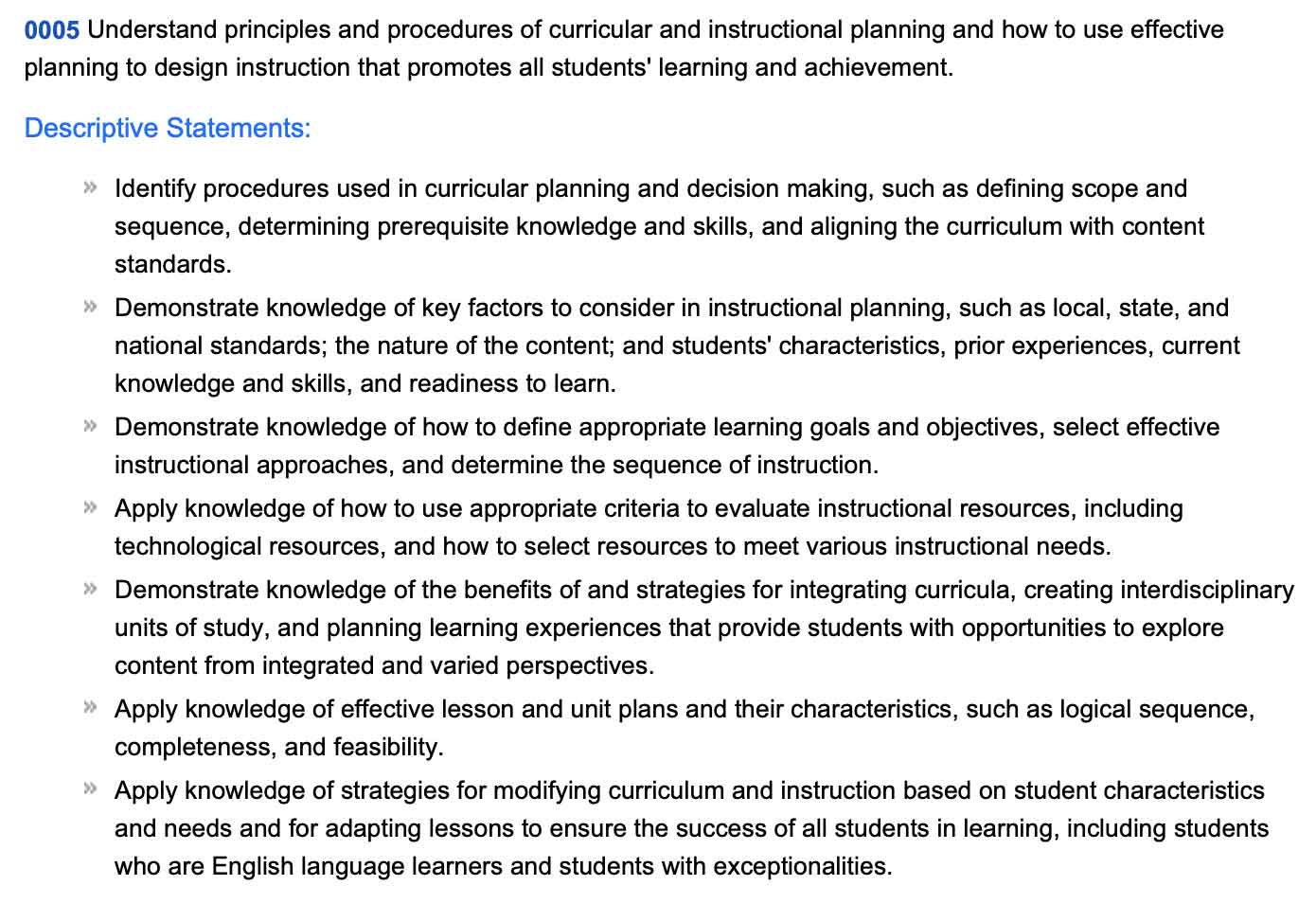
Learning Goal Versus Learning Objective
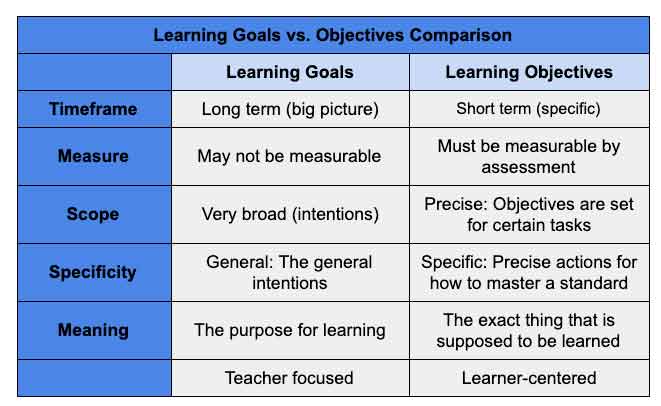
In summary, the learning goal is a broad learning outcome that students will master by the end of a subject and should represent a general overview of the course. Learning goal examples:
- Students will work effectively in groups.
- Students will learn effective reading and math strategies.
Both of the mentioned learning goals are essential for success; however, they are not easily measured.
The learning objective details a specific learning outcome, which comes from the course goal. ALL learning objectives should be measurable which means that a teacher should be able to tell (usually using formal or informal assessment) if students have mastered a learning objective. For example:
Learning goal: Students will learn effective math strategies.
Learning objective: When asked to use math strategies students will be able to:
- Use an array method to solve a 2×2 multiplication problem.
- Use the standard algorithm to solve a 2×2 multiplication problem.
- Use pictorial models to solve a 2×2 multiplication problem.
Backwards Design
Backwards design helps teachers create lessons and units that are goal (learning) focused rather than process (teacher) focused. Since many teachers usually start planning a lesson from the beginning, backwards design can be counterintuitive, but beginning with the end in mind can be very beneficial for teachers and students. An example of the process would be:
- A teacher reviews and understand the learning standards for his/her students by then end of the lesson, unit, or grade level.
- The teacher will then make a list of the things the students absolutely need to know by the end of the lesson, unit, or grade level.
- Based on the list of essential standards the teacher makes, he/she will then design an assessment that measures how well students have mastered the necessary concepts.
- Then, the teacher will design a lesson or series of lessons, projects, and strategies to help students acquire the skills necessary to master the standards.
- The teacher plans different types of formative assessments to assess students through the learning process. Based on the results of the formative assessment, the teacher will differentiate lessons and provide needed enrichment/intervention.
- The teacher will reflect on the plan and hopefully discuss the plan with peers who can provide feedback and suggestions.
Advantages to backwards design are:
- Students are encouraged to understand the overall goal for the lesson or unit and keep a focus on that rather than concentrating too heavily on the basic facts.
- Assessments are designed prior to instruction and are planned based on the necessary standards. Instruction driven by valid assessment is very successful.
- Instruction is focused on the “big picture” understanding and lessons are created with a clear vision of the overall goals for a unit.
Disadvantages to backwards design could be:
- Teachers might misinterpret the standards and, therefore, their whole lesson design would be skewed
- Textbooks and state standards are not always explicit or highlight key or broad concepts for a lesson or unit.
- If an end goal is assumed by the teacher prior to a unit, students may not be pushed beyond that goal and some may not reach their fullest potential.
Modifying Curriculum and Instruction
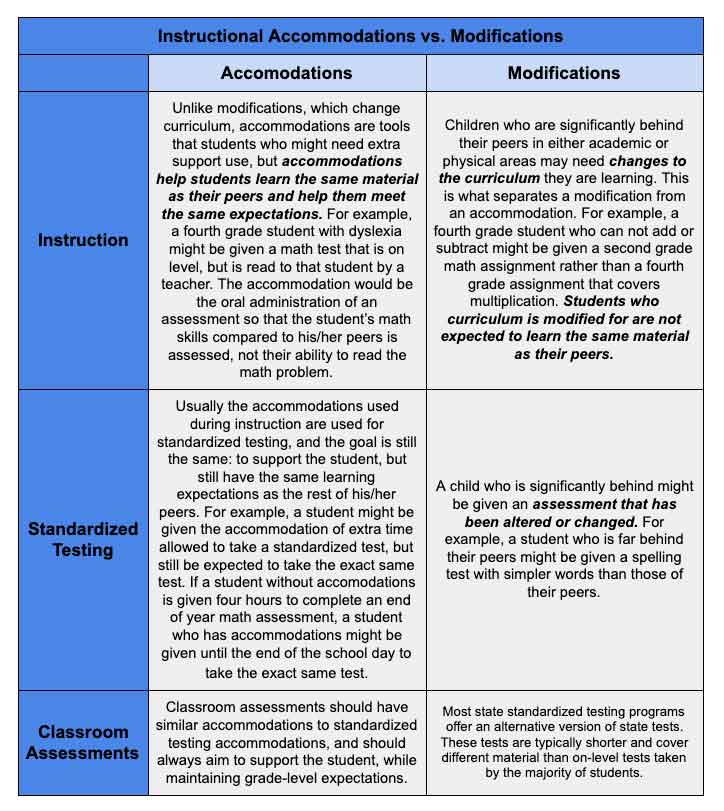
Classroom and testing accommodations help support students while maintaining grade level expectations. Common accommodations include:
- Listening to audio versions of books.
- Teacher providing a copy of class notes.
- Extra time given to complete an assignment.
- Teacher gives instructions with no more than three steps.
- Student is allowed extra time to complete an assessment or assignment.
- Student is given preferential seating near the teacher.
Classroom and testing modifications change learning expectations for students to where students are no longer expected to work on the same level as their peers. Modifications are used rarely, and only in the case that a student is significantly behind academically or developmentally compared to his/her peers. Common modifications include:
- Answer less complex questions than peers.
- Be given fewer answer choices than peers.
- Be graded using a different rubric than peers.
- Be excused from certain tests, projects, or assignments.
Instructional Approaches
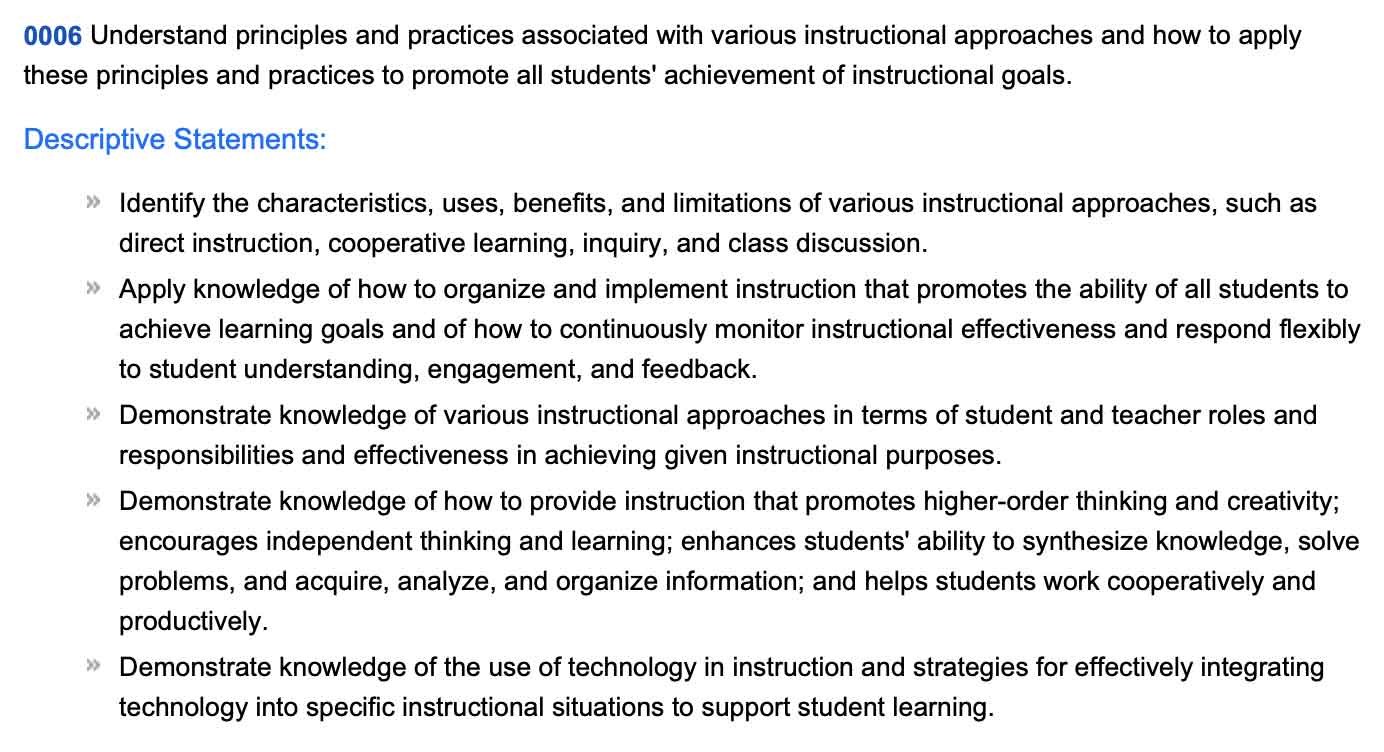
The following concepts are important to know.
Cooperative Learning
Cooperative learning is an instructional strategy that involves students working together in small groups on activities or projects. The goal of cooperative learning is to help students reach academic learning targets, but also to learn how to work together, agree and disagree respectfully, and use their voice. Cooperative learning can be used throughout the learning process, but works best to work on mastering an already presented topic, but before the assessment.
An example of cooperative learning is the jigsaw method: A teacher has presented a lesson over Native Americans and he wants his students to work cooperatively to understand the topic better. The teacher would start by choosing groups and assigning a role to each member of the group. One student might be responsible for researching where they lived, one might be responsible for research the food they eat, one might be responsible for researching the types of homes they lived in, etc. Then, once students have had time to research their topic, they would come back together and share their information, so after the activity each group member understands all topics.
Cooperative learning benefits include:
- Improved academic success: Research has proven that cooperative learning enhances learning for students across ethnic, geographic, and socioeconomic demographics. When students are given the chance to work cooperatively, they are exposed to other types of learners they might not interact with otherwise.
- Improved higher level thinking: Higher level thinking develops through encountering different ways of solving a problem, and cooperative learning provides a great opportunity for students to think about various ways to solve a problem.
- Self awareness: When students work cooperatively they are given the opportunity to discover how they learn best, what their strengths or weaknesses are, and how to share ideas in a safe place.
Limitations of cooperative learning include:
- Students must depend on one another.
- There is a lot of noise, and it can be difficult to tell if students are on task.
- Can be difficult to grade.
Characteristics of cooperative learning include:
- Dividing labor among students.
- Students interacting face-to-face.
- Students have specific assignments within the group.
- Positive interdependence is required to fully complete the task/assignment.
- Social skills develop as a result of cooperative learning.
Inquiry
Inquiry-based learning is a learning approach that maximizes the student’s role in the learning process. The inquiry-based method allows students to build knowledge through exploration, experience, and discussion. Teachers who use inquiry based methods encourage students to explore content material, ask questions, and share ideas.
The benefits of inquiry-based learning include:
- Enhanced learning experiences for students.
- Fosters curiosity.
- Encourages students to take ownership in their learning.
- Students are more engaged with the material.
- Creates a love of learning.
An example of a guided inquiry lesson where students are investigating how water boils, a teacher will create a question that will guide students to an outcome already known. Students will drive the discussion based on their observations and what they are wondering. Students might pose a question like, “How much time would it take to melt ice cubes in boiling water?”
Inquiry-based learning limitations include:
- Students could be reluctant to participate.
- Assessing students can be difficult.
Motivation and Communication
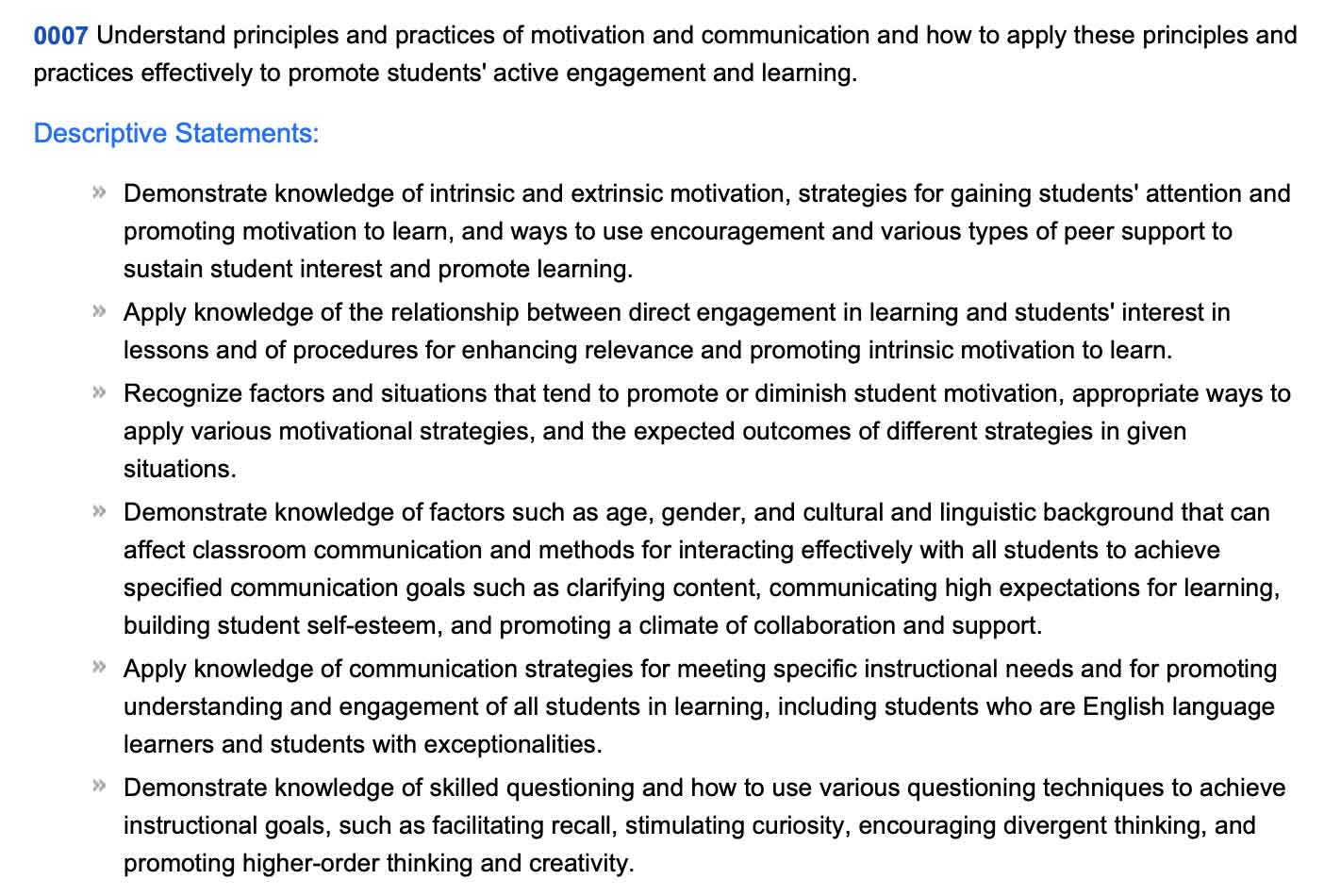
Take a look at these concepts that are likely to appear on the test.
Motivational Theory
Motivational theory is the reasoning behind why people choose to do what they do. When it comes to students, this is very important to understand because students will learn at a much deeper level when they are motivated. There are two basic types of motivation, intrinsic and extrinsic.
Intrinsic motivation is self-driven and in the classroom would refer to a student who pursues learning themselves because they are excited or interested in a topic. For example, a student is passionate about planets, so when the unit over the Sun came up, the student took it upon herself to research and read as much about the Sun as possible. She was not only very successful on end of unit assessments, but she was also able to contribute valuable questions and discussion points to the class.
Extrinsic motivation is driven by external factors such as teachers or parents. An example would be that a student tries to make all A’s on his/her report card not because he/she was passionate about learning, but because he/she was offered a reward by a parent.
Both examples listed above explain a scenario where a student was successful; however, as teachers we hope to see students who are intrinsically motivated to learn. Intrinsic motivation is going to be much stronger and last longer than extrinsic motivation. There are five basic factors that negatively impact student motivation:
- Relationships (or lack of)
- Lack of effort
- Lack of goals, dreams, hope of the future
- Learning difficulties
- Stress or worry about factors in or out of the school setting
Strategies for motivating students include:
- Building strong relationships with every student
- Using a variety of student-centered learning activities
- Setting realistic performance goals
- Not over emphasizing grades and test scores
- Praising much more than criticizing, and when criticism is necessary, doing so constructively
- Giving students as many choices in their education as possible
Building Self-Esteem
When students are proud of themselves and their work, they will continue to work hard to surpass goals. Teachers have the unique opportunity to help build self-esteem in children starting from a very early age. Teachers can build self-esteem in students by:
- Accepting students as they are.
- Helping students take responsibility for their learning.
- Increasing student ownership of the classroom.
- Teaching self-discipline skills.
- Teaching students how to advocate for themselves.
- Providing consistent praise and positive feedback.
- Teaching students coping skills so when things don’t go their way, they are still able to find the positive and learn from the situation.
The more self-esteem students have, the more positive the learning environment will be.
Positive self-image and high self-esteem are a huge factor in student success, and those qualities will impact students far beyond the elementary school classroom.
The Learning Environment
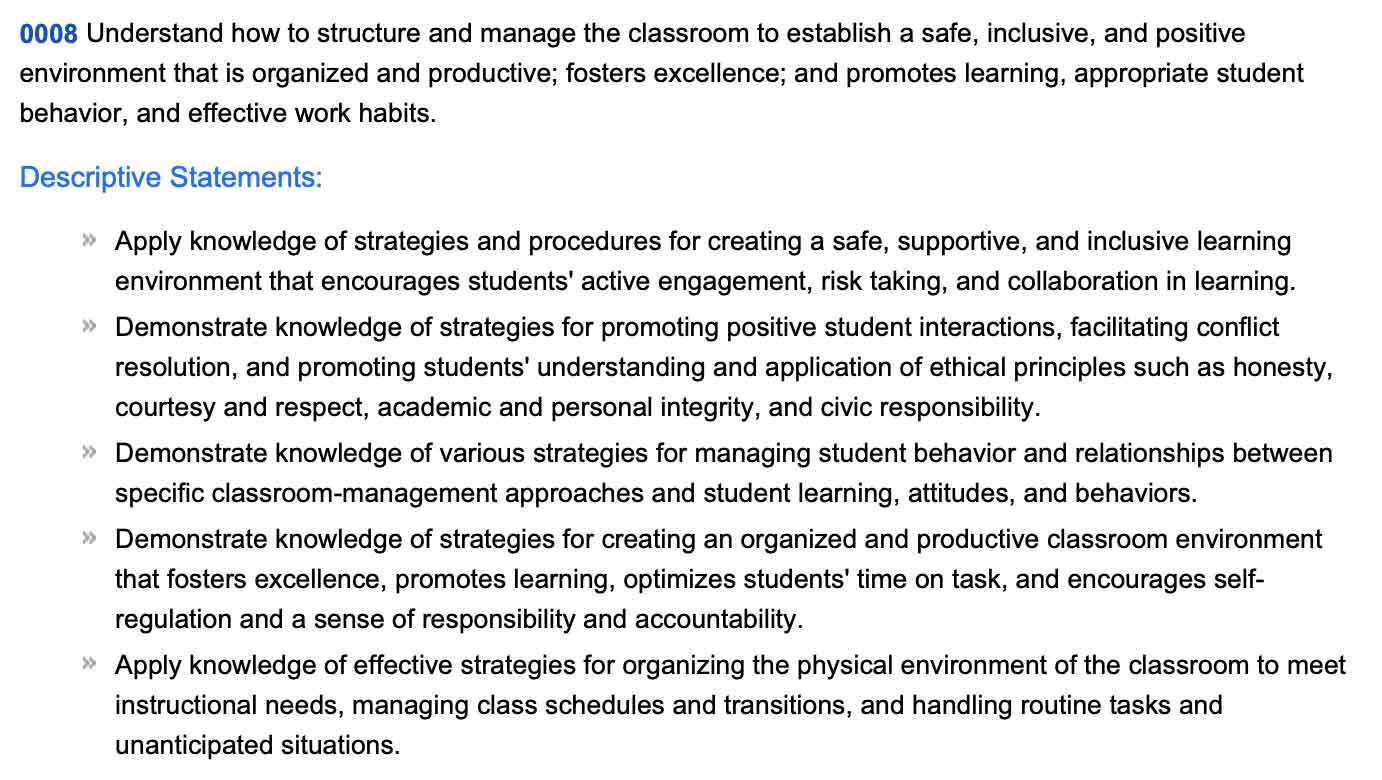
The following are really important concepts from this competency.
Facilitating Conflict Resolution
Classrooms will inevitably have conflict between students. It is important that teachers use conflict resolution strategies that are age appropriate.
Generally, these are the steps to facilitating conflict resolution:
- Give children a “cool off” time.
- Let the child who has been wronged state the problem.
- The other child will listen and then re-state the issue.
- Allow the second child to state his/her feelings.
- The first child will paraphrase the second child’s feelings.
- Continue the process until both children feel heard and understood.
- The children find a solution.
Other conflict resolution strategies include:
- Role playing.
- Giving students the opportunity to journal or write about conflict and the emotions that go along with conflict they’ve experienced in the classroom.
- Teaching listening skills.
- Make eye contact with the speaker
- Ask questions
- Do not give advice or offer suggestions
- Repeat what you’ve heard in your own words
Conflict resolution skills are necessary to maintain a peaceful learning environment in the classroom because children will use the conflict resolution skills they learn early on for the rest of their lives, so it is very important to intentionally make the most out of teaching moments.
Managing Student Behavior
Classroom management is an essential skill that a teacher must have in order to best educate his/her students. A classroom with no management is chaotic, hostile, and not the best learning environment for any student. Classroom management strategies vary depending on grade level and specific needs of students, however there are a few basic principles of classroom management that apply to most classrooms:
- Build relationships (with students and parents) early.
- Make as many positive phone calls home as possible. When you’ve already had a positive interaction with a parent and he/she knows you support his/her child, they are more likely to intervene on your behalf if their child needs to be disciplined.
- Celebrate hard work. Work on praising the process, rather than a specific outcome or score. The more students are praised, the less likely they are to disrupt the learning process.
- Maintain authority all year.
- Make sure students understand your expectations, and depending on the age group, allow student input when deciding what the classroom needs to run smoothly.
- Accommodate ALL learners in your classroom.
- Prepare so that lessons are engaging. Students who are engaged are far less likely to act out.
Many teachers at the elementary level have found positive behavior systems to be useful. Students can set class behavior goals, and also personal goals. Students earn a tangible item for positive behavior (marbles in a jar, pom-pom balls in a jar, beads, etc.) and as the item reaches different levels in the container students earn rewards. A money system is also something that can not only reward positive behavior, but can also teach responsibility and financial literacy which are two necessary skills for lifelong success.
And that is some basic information about Domain II: Assessment, Instruction and the Learning Environment of the Professional Knowledge: Elementary exam.
Professional Knowledge Elementary Domain III: The Professional Environment
Overview
Professional Knowledge Elementary domain III has about 20 multiple-choice questions and 1 constructed-response (work product) question which account for about 26% of the entire test.
This content domain contains 2 competencies:
- Effective Collaboration
- Responsibilities, Ethics, and Professional Growth
Effective Collaboration
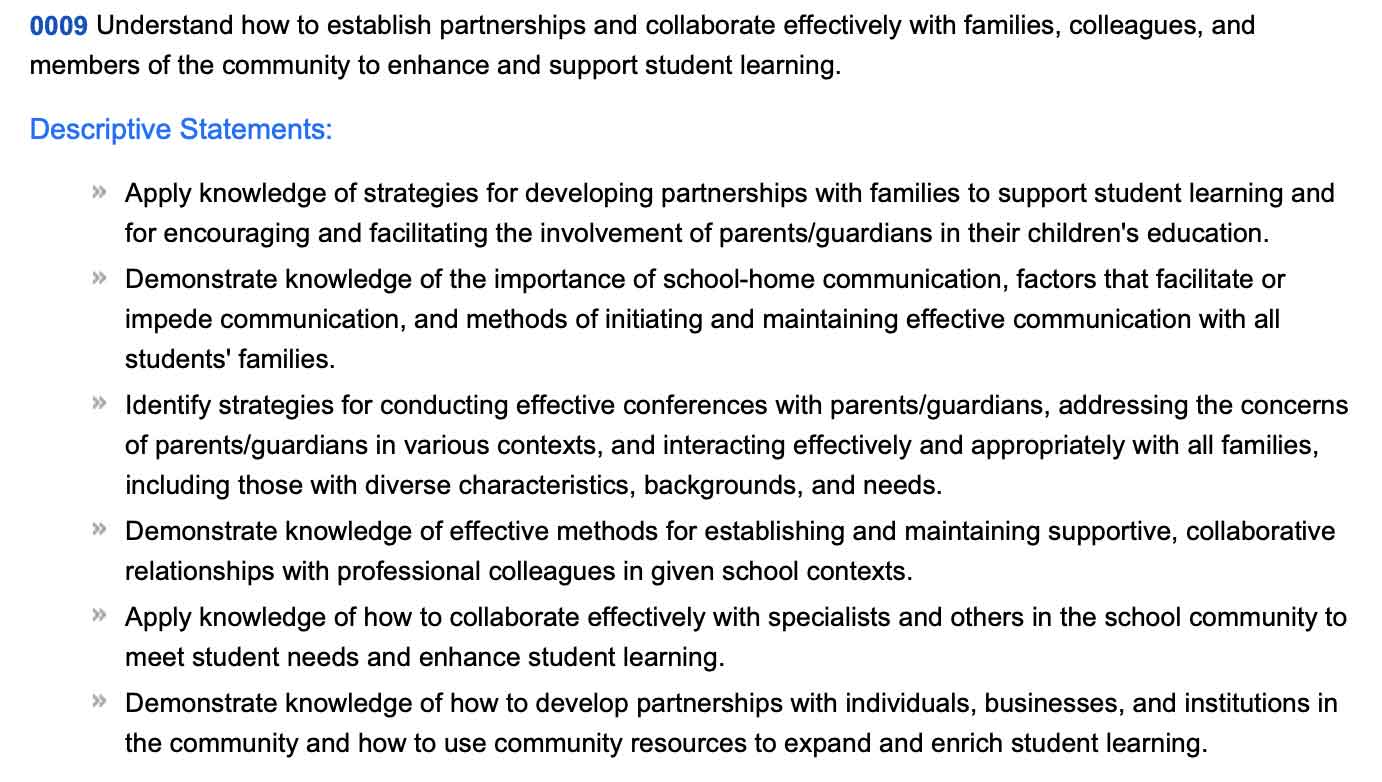
Take a look at these concepts that are likely to appear on the test.
Effective Parent/Teacher Conferences
Parent/teacher conferences are valuable meetings where teachers have the opportunity to discuss a student’s progress, strengths, or struggles with parents. It is important to communicate these things to parents so they feel invited into the learning process for their child, and so that if their child is facing learning challenges they are aware of that. When leading a parent/teacher conference, teachers should:
- Offer as flexible of a meeting schedule as possible.
- Prepare for the meeting with work samples and necessary data.
- Be sure to invite a translator if necessary.
- Sit next to the parent, not across from if possible.
- Share factual information and bring data to present to the parent.
- Begin and end the conference with a positive about the child.
- Avoid terms only teachers are familiar with such as education acronyms. If you need to use them, explain to the parent what the acronym means.
- Encourage questions from parents.
- Do not engage in any type of hostile behavior.
- Remain professional at all times.
- Stay in contact/follow up with parents after the conference.
School-Home Communication
Communicating with parents/guardians is very important. Education is a team effort, and one of the most important pieces is the people each student goes home to. The majority of parent contacts should be positive, but some may need to deliver news parents do not want to hear. Most elementary teachers try to make contact with every parent the first week of school. That is important because if the first (and majority of) communication is positive, than if you ever need to make a difficult call home, the parent is usually much more receptive.
The main methods of communication for teachers are:
- Phone call
- Communication apps like Remind 101
- In person
It is important that teachers understand factors that can impede and facilitate communication between teachers and parents.
Factors that can impede communication include:
- Language barriers
- Work schedules for parents
- Lack of technology in the home
- Negative view of teachers/school
Factors that can facilitate communication include:
- Being available before and after school.
- Providing parents with all of your professional contact information.
- Building positive relationships.
- Asking parents how/when they prefer to be contacted.
Responsibilities, Ethics, and Professional Growth
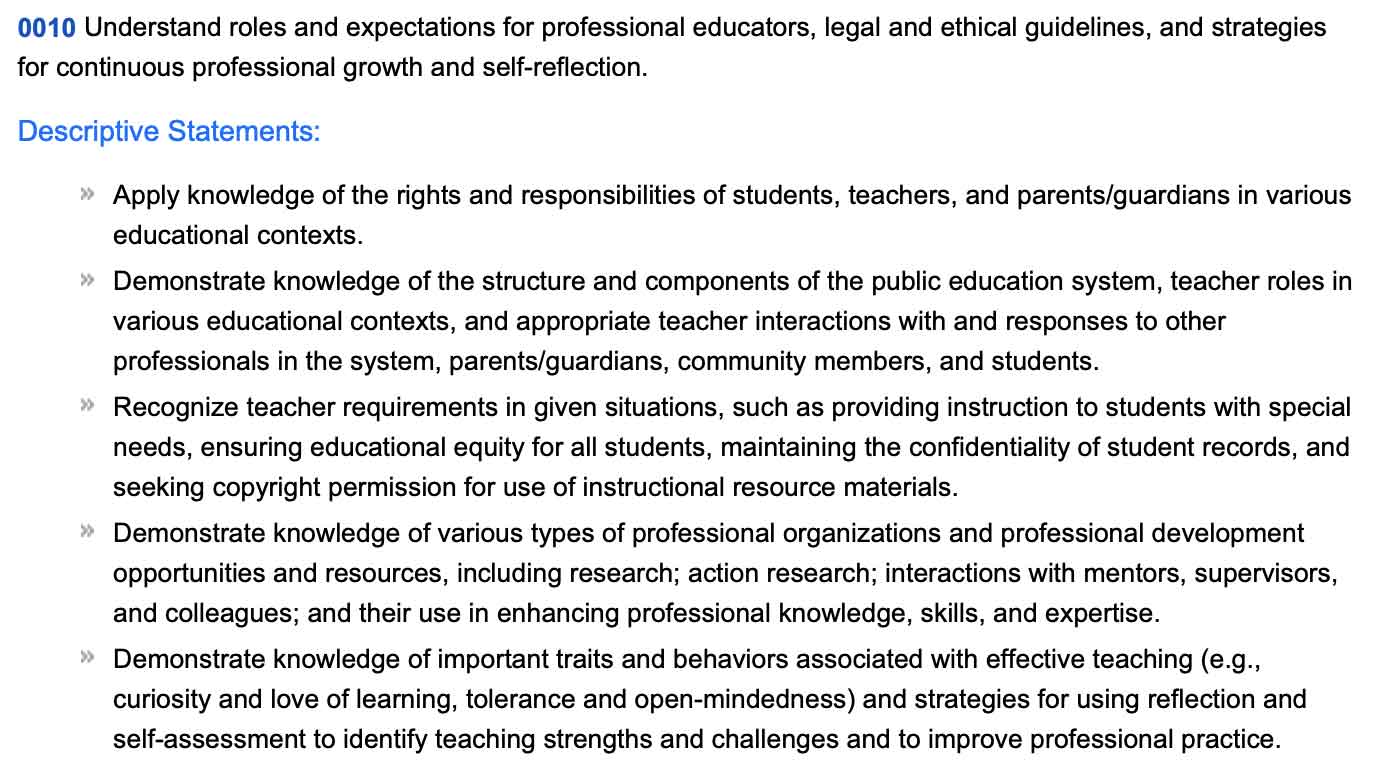
Reflection and Self-Assessment
Reflection and self-assessment are important for any occupation, but essential for effective teaching. Teachers should reflect on their practice after each lesson and constantly strive to provide the best education possible to their students. All teachers have strengths and weaknesses, so identifying those and striving to amplify the strengths and improve any weakness is essential. One way to do this is to ask reflective questions such as:
Was the activity we did in class successful? Why or why not?
Are the relationships I have with my students helping them learn?
Could the behavior problems I have in class be managed by different expectations?
What choices have I given my students lately?
Teachers should always be striving to better their practice. It is important that teachers set realistic and measurable goals that can come from self-reflection questions. Most teachers will do this with campus administration, but it is also important to do independently so that different aspects of teaching are constantly being improved upon.
FERPA
FERPA is the Family Educational Rights and Privacy Act which is a federal law that protects student educational records and details the information that can and can not be shared about the student.
Due to FERPA teachers can not:
- Use educational technology programs that the school district does not have a contract with.
- Send grades or other confidential information containing student names through email.
- Post student information online without parental consent.
- Connect with students on social media classroom pages without parental consent.
Schools that are found to have violated student privacy can lose federal funding and legal action can be taken.
Equity
Equity in education requires schools to put systems in place that ensure every child has an equal chance for success. To ensure equity in a school system, the schools must understand the needs (challenges) of all students/populations of students and provide support through special programs to help students overcome those challenges. An example would be programs such as Special Education, bilingual/ESL, dyslexia, etc. These programs ensure that no matter the challenge students face, every child has the opportunity for success.
And that is some basic information about Domain III: The Professional Environment of the Professional Knowledge Elementary exam.
NES Professional Knowledge Elementary Constructed-Response Breakdown
Overview
There are 2 constructed-response assignments on the exam:
- Case study
- Work product
So, let’s break down the case study first.
Case Study
The NES Professional Knowledge Elementary test will have two constructed-response written assignments. One is a case study, consisting of two charges. The other is a work product (explained below). You will need to read both assignments carefully before responding. Your response is scored based on how you communicate your message to the audience and how well you apply your professional knowledge in your response. The case study could consist of background information, sample assignment, excerpt from teacher’s notes. From that information you could be asked to:
Write a response in two parts based on the elements of the case study presented.
Part 1: Describe a strategy the teacher used to try and ensure student success, and explain why this strategy was a good one to try.
Part 2: Describe one additional strategy the teacher could have used to help ensure student success in learning and explain why this strategy would have been effective in helping ensure student success in learning.
For a complete example (including strong and weak response examples) go to https://www.nestest.com/Content/Docs/NES_Profile_051.pdf page 13.
Your response should:
- Provide sound reasoning and relevant support.
- Be 200-300 words.
- Stay focused on the topic.
- Must be original (no reference materials are allowed).
- Be edited carefully by you for any errors.
The constructed-response items (including the case study) are graded using the following rubric:
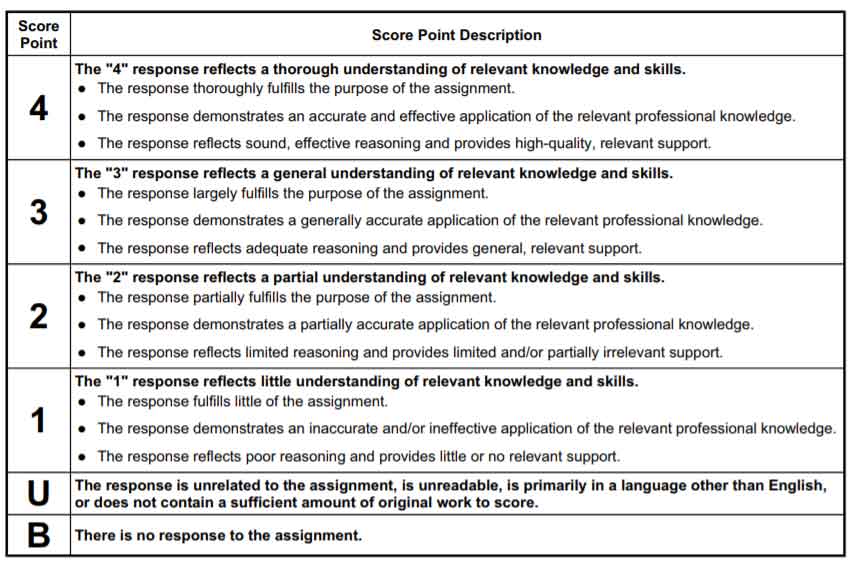
Work Product
The work product constructed-response item is a part of Domain 3: Professional Environment and could look like:
Use the information below to complete the assignment that follows.
Imagine that you are a new elementary teacher. Your principal has asked you to serve on a faculty committee whose goal is to identify ways to increase teachers’ use of reflective practice. Members of the school community have been concerned about declining student achievement in recent years, and increased use of reflective practice by teachers has been identified as one way to enhance teaching and learning at the school. Increased use of reflective practice by teachers is a goal for the following year.
Write a response to other members of the committee describing your ideas about the issue of teachers’ use of reflective practice. Your response should:
- Explain why teachers’ use of reflective practice is important;
- Describe two steps school staff can take to increase teachers’ use of reflective practice; and
- Explain why each step you describe would be effective in increasing teachers’ use of reflective practice.
Just like the case study, your response should:
- Provide sound reasoning and relevant support.
- Be 200-300 words.
- Stay focused on the topic.
- Be original (no reference materials are allowed).
- Be edited carefully by you for any errors.
A sample strong and weak response for the work study can be found at
https://www.nestest.com/Content/Docs/NES_Profile_051.pdf (page 18-19).
The same scoring rubric from above is used to score the work study constructed-response question.

